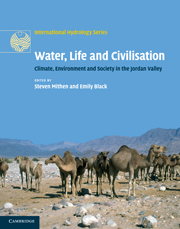Book contents
- Frontmatter
- Contents
- List of figures
- List of tables
- List of contributors
- Acknowledgements
- 1 Introduction: an interdisciplinary approach to Water, Life and Civilisation
- Part I Past, present and future climate
- Part II The palaeoenvironmental record
- 6 A review of palaeoclimates and palaeoenvironments in the Levant and Eastern Mediterranean from 25,000 to 5,000 years BP: setting the environmental background for the evolution of human civilisation
- 7 Palaeoenvironments of the southern Levant 5,000 BP to present: linking the geological and archaeological records
- 8 Using proxy data, historical climate data and climate models to investigate aridification during the Holocene
- 9 Palaeoenvironmental and limnological reconstruction of Lake Lisan and the Dead Sea
- Part III Hydrological studies of the Jordan Valley
- Part IV Human settlement, climate change, hydrology and water management
- Part V Palaeoeconomies and developing archaeological methodologies
- Part VI Society, economy and water today
- Part VII Conclusions
- Index
- Plate section
- References
9 - Palaeoenvironmental and limnological reconstruction of Lake Lisan and the Dead Sea
from Part II - The palaeoenvironmental record
Published online by Cambridge University Press: 26 April 2011
- Frontmatter
- Contents
- List of figures
- List of tables
- List of contributors
- Acknowledgements
- 1 Introduction: an interdisciplinary approach to Water, Life and Civilisation
- Part I Past, present and future climate
- Part II The palaeoenvironmental record
- 6 A review of palaeoclimates and palaeoenvironments in the Levant and Eastern Mediterranean from 25,000 to 5,000 years BP: setting the environmental background for the evolution of human civilisation
- 7 Palaeoenvironments of the southern Levant 5,000 BP to present: linking the geological and archaeological records
- 8 Using proxy data, historical climate data and climate models to investigate aridification during the Holocene
- 9 Palaeoenvironmental and limnological reconstruction of Lake Lisan and the Dead Sea
- Part III Hydrological studies of the Jordan Valley
- Part IV Human settlement, climate change, hydrology and water management
- Part V Palaeoeconomies and developing archaeological methodologies
- Part VI Society, economy and water today
- Part VII Conclusions
- Index
- Plate section
- References
Summary
ABSTRACT
Lake Lisan existed between 75 and 14 ka BP and provides a unique opportunity for investigating climate change for the southern Levant region. The exposures of Lake Lisan deposits on the eastern shores of the current Dead Sea have received limited study in comparison to the western shores. Here we present new U-series and elevation data for a sequence of Lisan deposits ranging between 25 and 8 ka BP. The data show an elevation–age record consistent with previously published data while providing new information about the extent of decrease in lake levels in the Late Pleistocene and early Holocene. All dates cited in this chapter are calibrated; those that were uncalibrated in their original publications were calibrated using the online OxCAL program.
INTRODUCTION
Lake Lisan existed from approximately 70 to 15 cal ka BP (see Kaufman, 1971, Kaufman et al., 1992, Schramm et al., 2000; Hasse-Schramm et al., 2004 and references therein) and extended up to 200 km along the Dead Sea Transform at its highest levels (Hazan et al., 2005; Chapter 6, this volume; Figures 9.1, 9.2). During its history, the lake fluctuated between highstands of 165–180 mbsl (metres below sea level) and lowstands of perhaps as much as 700 mbsl (Chapter 6, this volume; Begin et al., 1985, Bartov et al., 2002).
- Type
- Chapter
- Information
- Water, Life and CivilisationClimate, Environment and Society in the Jordan Valley, pp. 113 - 128Publisher: Cambridge University PressPrint publication year: 2011
References
- 2
- Cited by

